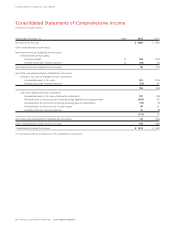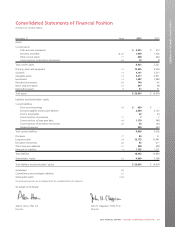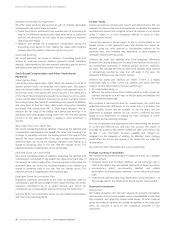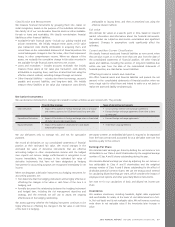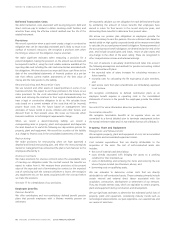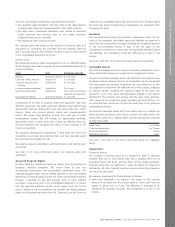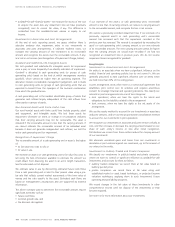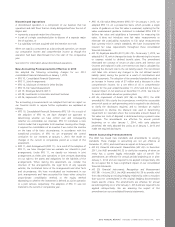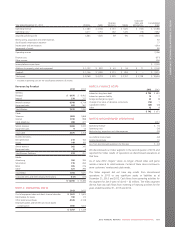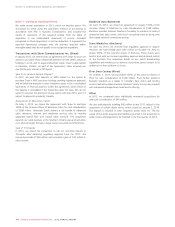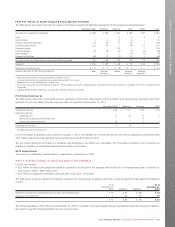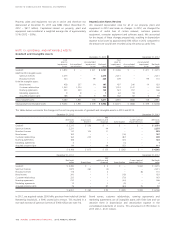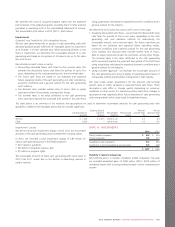Rogers 2013 Annual Report Download - page 103
Download and view the complete annual report
Please find page 103 of the 2013 Rogers annual report below. You can navigate through the pages in the report by either clicking on the pages listed below, or by using the keyword search tool below to find specific information within the annual report.
NOTES TO CONSOLIDATED FINANCIAL STATEMENTS
We incur costs related to subscriber acquisition and retention.
• We capitalize cable installation costs that relate to the cable network
and depreciate them over the expected life of the cable customer.
• We defer direct incremental installation costs related to reconnect
Cable customers and amortize them as the related reconnect
installation revenues are recorded.
• We expense all other costs as incurred.
We calculate gains and losses on the disposal of property, plant and
equipment by comparing the proceeds from the disposal with the
item’s carrying amount, and recognize the gain or loss in other income
in the consolidated statements of income.
Depreciation
We depreciate property, plant and equipment over its estimated useful
life by charging depreciation expense to the consolidated statements of
income as follows:
Asset Basis Estimated useful life
Buildings Diminishing balance 5 to 25 years
Cable and wireless network Straight-line 3 to 30 years
Computer equipment and
software
Straight-line 4 to 10 years
Customer premise equipment Straight-line 3 to 5 years
Leasehold improvements Straight-line Over shorter of estimated
useful life and lease term
Equipment and vehicles Diminishing balance 3 to 20 years
Components of an item of property, plant and equipment may have
different useful lives. We make significant estimates when determining
depreciation methods, depreciation rates and asset useful lives, which
requires taking into account industry trends and company-specific
factors. We review these decisions at least once each year or when
circumstances change. We will change our depreciation methods,
depreciation rates or asset useful lives if they are different from our
previous estimates. We recognize the effect of these changes in net
income prospectively.
We capitalize development expenditures if they meet the criteria for
recognition as an asset, and amortize them over their expected useful
lives once they are available for use.
We expense research expenditures and maintenance and training costs
as incurred.
See note 12 for more information about our property, plant and
equipment.
Acquired Program Rights
Program rights are contractual rights we acquire from third parties to
broadcast television programs. We record them at cost less
accumulated amortization and accumulated impairment losses. We
capitalize program rights and the related liabilities on the consolidated
statements of financial position when the licence period begins and the
program is available for use, and amortize them to other external
purchases in operating costs in the consolidated statements of income
over the expected exhibition period, which ranges from one to five
years. If programs are not scheduled, we consider the related program
rights to be impaired and write them off. Otherwise, we test them for
impairment as intangible assets with finite useful lives. Program rights
for multi-year sports programming arrangements are expensed when
the games are aired.
Goodwill
We record goodwill arising from business combinations when the fair
value of the separately identifiable assets and liabilities we acquired is
lower than the consideration we paid (including the recognized amount
of the non-controlling interest, if any). If the fair value of the
consideration transferred is lower than the separately identified assets
and liabilities, we immediately record the difference as a gain in net
income.
See note 7 and note 13 for more information about our goodwill.
Intangible Assets
We record intangible assets we acquire in business combinations at fair
value, and test for impairment as required (see Impairment, below).
We do not amortize intangible assets with indefinite lives (spectrum and
broadcast licences) because there is no foreseeable limit to the period
that these assets are expected to generate net cash inflows for us. We
use judgment to determine the indefinite life of these assets, analyzing
all relevant factors, including the expected usage of the asset, the
typical life cycle of the asset and anticipated changes in the market
demand for the products and services that the asset helps generate.
After review of the competitive, legal, regulatory and other factors, it is
our view that these factors do not limit the useful lives of our spectrum
and broadcast licences.
We amortize intangible assets with finite useful lives on a straight-line
basis over their estimated useful lives as noted in the table below. We
review their useful lives, residual values and the amortization methods
at least once a year.
Brand names 7 to 20 years
Customer relationships 3 to 10 years
Roaming agreements 12 years
Marketing agreements 3 years
See note 7 and note 13 for more information about our intangible
assets.
Impairment
Financial Assets
We consider a financial asset to be impaired if there is objective
evidence that one or more events have had a negative effect on its
estimated future cash flows, and the effect can be reliably estimated.
Financial assets that are significant in value are tested for impairment
individually. All other financial assets are assessed collectively based on
the nature of each asset.
We measure impairment for financial assets as follows:
•loans and receivables – we measure the excess of the carrying
amount of the asset over the present value of future cash flows we
expect to derive from it, if any. The difference is allocated to an
allowance for doubtful accounts, and recognized as a loss in net
income.
2013 ANNUAL REPORT ROGERS COMMUNICATIONS INC. 99



